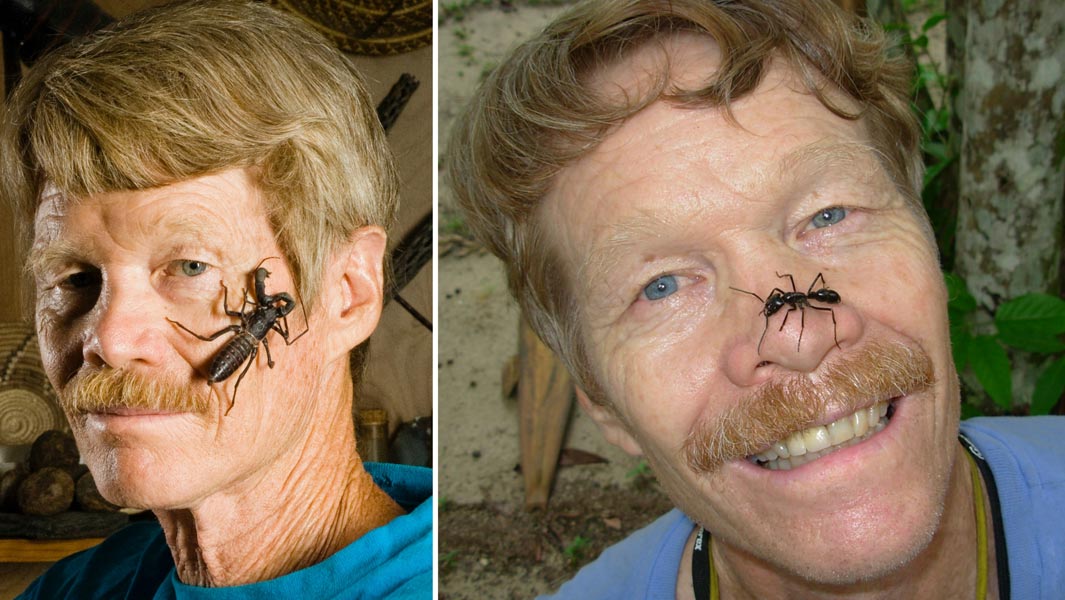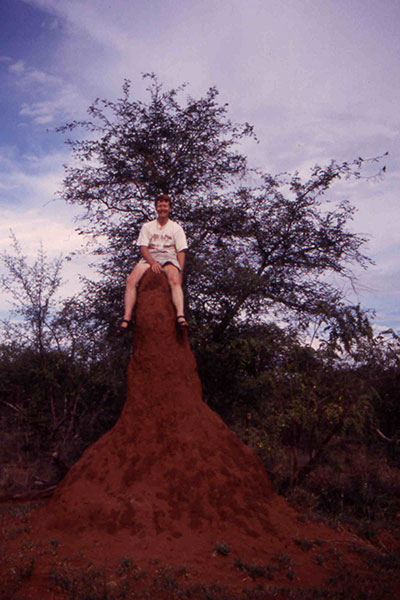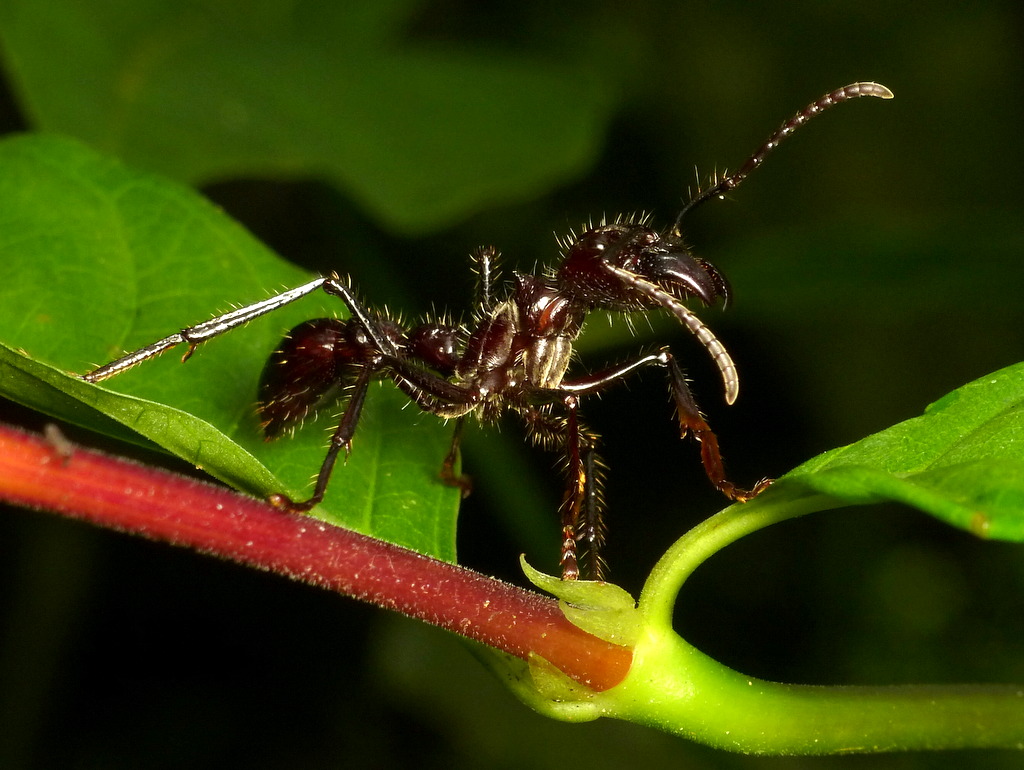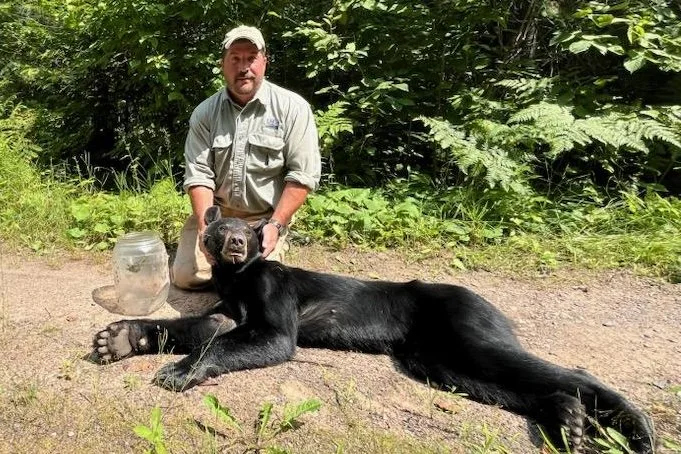Think your job is painful? Try spending a workday with Justin Schmidt, father of the Schmidt sting pain index.

Just a normal day on the job for Justin Schmidt, who created the Schmidt sting pain index. Image credit: Justin Schmidt via Guiness World Records
While most of us try to avoid insect stings at all costs, one scientist has made it his goal to learn everything there is to know about them.
Dr. Justin Schmidt, an entomologist at the Southwestern Biological Institute in Arizona, United States, estimates that he has been stung by 150 different species over a thousand times – mostly accidentally, but occasionally on purpose. His goal was to create an excruciatingly comprehensive pain index that ranks 83 of those species on a spectrum of 1 to 4 according to the intensity of their stings.

‘Aspiration’, that is, gently hoovering a bug into a tube-fed container known as a pooter, is a method entomologists use to AVOID getting stung by insects. But Schmidt had a different goal this time. Image credit: Justin Schmidt via Guiness World Records
The index arose from the pursuit of a larger hypothesis according to which the evolution of sociality in Hymenoptera (bees, wasps, ants, etc.) was dependent on the evolution of venom that was both painful and toxic. Pain is a signal of damage in the body, but molecules that produce pain and molecules that are toxic and actively cause damage are different from each other. Although pain itself acts as a deterrent, with repeated exposure intelligent predators will learn the dishonesty of the signal – that, in fact, there is no real damage being done.
Early Hymenoptera were primarily solitary, and in their case the pain alone would give them the chance to escape. Also, solitary insects do not provide a high energy reward for predators, which therefore do not make a significant effort to hunt them. However, with the evolution of sociality many insects cluster together in colonies which are a nutritionally rich and thus worthwhile target. Without other defenses than pain, predators would prey on the defenseless society, leaving few surviving individuals. In this case sociality would not be beneficial, so Hymenoptera needed a defense beyond a painful sting to protect their whole colony. Their sting was a signal of damage, and toxicity evolved as its truth content. With a toxic sting, and thus the ability to protect against predators, Hymenoptera were able to progress towards sociality and its associated evolutionary benefits such as the shared raising of youth, inter-colony communication, individual task specialization, and food storage.

Dr Schmidt travels a lot during his work studying insects. Here, he is pictured atop a termite mound in Australia. Ouch. Image credit: Justin Schmidt via Guiness World Records
In order to study this evolutionary connection between toxicity and sociality, Schmidt recognized the need for a quantitative measure to rank the painfulness of stings. Toxicity is already well characterized and can be quantified, but without the Schmidt sting pain index, scientists would not be able to relate the amount of sociality to the level of pain, making the study of the above hypothesis impossible.
Now, here’s a short summary of how some of the 83 insects index rank and how long the pain from their sting lasts. Some of Schmidt’s hilarious descriptions are also included.
Level 1
Some of the insect stings Schmidt considers to be at this level include those of the Western paper wasp, the graceful twig ant, the Southern fire ant, the urban digger bee, and most small bees. The duration of the pain of insect stings in this category is, generally, five minutes or less.
Feeling only slight pain, Schmidt described the sting of an urban digger bee, categorized into this level, as “almost pleasant, a lover just bit your earlobe a little too hard.” Also rated into this category, the entomologist described the sting of a sweat bee as “light, ephemeral, almost fruity. A tiny spark has singed a single hair on your arm.”
Level 2
Schmidt set the Western honey bee’s sting at a pain level of 2 to be the anchoring value and based his categorization of all other stings on it. A variety of bees, wasps, and ants fall into this category, including yellowjackets, the bald-faced hornet, the Asiatic honey bee, and the the trap-jaw ant. In their case, the duration of the pain from the sting generally lasts between five and ten minutes. The majority of Hymenopteran stings fall into this category.
According to Schmidt, the sting of a termite-raiding ant, whcih is listed in this category, has a similar feeling as “the debilitating pain of a migraine contained in the tip of your finger.” At the same time, he describes a yellowjacket’s sting as being “hot and smoky, almost irreverent. Imagine W. C. Fields extinguishing a cigar on your tongue.”

The tarantula hawk is in fact a large wasp. If you are ever stung by one, Schmidt says the best thing to do is to just lie down and scream: “The pain is so debilitating” and “screaming is satisfying,” he advises. Image credit: Jillian Cowles/Courtesy of Johns Hopkins University Press
Level 3
Most insects in this category are wasps, including the red-headed paper wasp, the neotropical red paper wasp, and Klug’s velvet ant (a wingless wasp, not a true ant). The duration of the sting pain can range anywhere from one minute to half an hour.
Some ants are also rated at this level, including the giant bull ant and the Maricopa harvester ant. Schmidt described the pain from the sting of the latter as: “After eight unrelenting hours of drilling into that ingrown toenail, you find the drill wedged into the toe.”
Level 4
We have arrived at the highest level in Schmidt’s sting pain index. His original index rated only one such example, the sting of the bullet ant, which he described as “pure, intense, brilliant pain…like walking over flaming charcoal with a three-inch nail embedded in your heel.”

The most painful insect sting in the world is that of the bullet ant, registering 4+ on the index. Image credit: In Memoriam: Ecuador Megadiverso
Schmidt later also included the sting of the tarantula hawk in this category, and he described the pain as “blinding, fierce [and] shockingly electric”, though the duration of pain from the sting is short-lived, lasting only approximately five minutes.
Schmidt also lists the sting of the warrior wasp in this category, describing it as “Torture. You are chained in the flow of an active volcano. Why did I start this list?”, noting the pain lasts up to two hours.

Dr Schmidt holding a tarantula hawk wasp – the Largest wasp species – whose sting is rated as an excruciating 4. Image credit: Justin Schmidt via Guiness World Records
To find out more about Dr Schmidt’s Sting Pain Index, check out his book, The Sting of the Wild. Also, you can read more of his hilariously entertaining sting pain descriptions here.
Oh, and avoid bullet ants at all cost!

